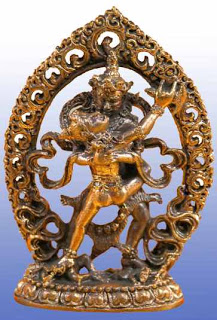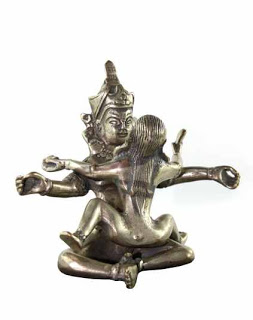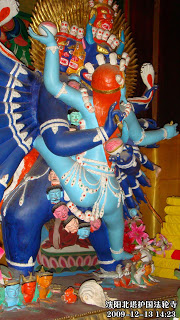| Home » 文章分类_English » True Face of the Dalai Lama |
True Face of the Dalai Lama: Playing around with all women in the world (2) Dalai Lama Never a Messenger of Peace |
True Face of the Dalai Lama: Playing around with all women in the world (2) Dalai Lama Never a Messenger of Peace(The above picture is the couple-practice of copulation in standing posture, a couple-body statue of Tibetan fake “Buddhism”, or called Lamaism; they falsely claim to have attained Buddhahood.) The lamas of the Tibetan Tantric School have been sexually abusing many women and girls for a long time; they collect money by fraud and are love swindlers. In his book, the Dalai Lama frankly says: For Buddhists, sexual intercourse can be used in the spiritual path because it causes a strong focusing of consciousness if the practitioner has firm compassion and wisdom. Its purpose is to manifest and prolong the deeper levels of mind. (described earlier with respect to the process of dying), in order to put their power to use in strengthening the realization of emptiness. Otherwise, mere intercourse has nothing to do with spiritual cultivation. When a person has achieved a high level of practice in motivation and wisdom, then even the joining of the two sex organs, or so-called intercourse, does not detract from the maintenance of that person’s pure behavior. Yogis who have achieved a high level of the path and are fully qualified can engage in sexual activity and a monastic with this ability can maintain all the precepts. (Dalai Lama XIV/translated and edited by Jeffrey Hopkins, How to Practice: The Way to a Meaningful Life, Pocket Books, a division of Simon & Schuster, Inc. NY, 2002, p.193.) In fact, sexual intercourse can never be the means of Buddhist practice because one should be away from the sexual desire in order to attain even the basic samadhi in Buddhism. However, Tibetan “Buddhism” (or called Lamaism, a fake Buddhism) uses it as an excuse for indulging in the sensual pleasures. The practice of all arhats, bodhisattvas and Buddhas needs to eliminate the sexual desire so that they can transcend the desire-realm. Therefore, in the three-vehicle bodhi of Buddhism, sexual intercourse is always disapproved because it is only a state of the mind-consciousness, which is equivalent to the state of the non-Buddhist eternalism. Only those who are ignorant of the real Buddhism will brag that sexual intercourse is also a Buddhist dharma. Such a statement from the Dalai Lama is only to make the lamas rightfully have sex with other people’s wives or daughters. Only those ignorant people who have blind faith in the famous Dalai Lama will cling to the lamas’ blessings and wrongly believe that one can attain Buddhahood through sexual intercourse. In fact, for those gurus of the Tibetan “Buddhism”, including the Dalai Lama, the Couple-Practice Tantra of Mahayoga (Anuttara-Yoga-Tantra) is only a deceptive excuse for their licentious behavior. The real Buddhist monastics take the precept of celibacy; one must be away from the greed for sexual love, with a pure body and mind, so that he can have the merits and virtues of samadhi. The Tibetan “Buddhism”, Lamaism led by the Dalai Lama, preaches adultery, which is a state in the lowest grade of desire-realm. Adultery, which violates the human ethics, is actually a behavior that will lead to the animal or hell path in the future lives of one and his followers; it is absolutely not a method of Buddhist practice. (Just think: If your wife has the couple-practice of copulation (Mahayoga) with a lama as shown in this picture, aren’t you wearing a green hat? Anyone who supports his wife to practice the teachings of “Tibetan Buddhism,” led by the Dalai Lama, will inevitably have this result.) The lamas of the Tibetan Tantric School have collected wealth illegally in Taiwan for many years; they have cheated the Taiwanese followers out of their resources and money. Again, they came to Taiwan for raising money by taking advantage of the disaster of Taiwan (August 8 Flood Disaster or called Typhoon Morakot Disaster). While the Taiwanese people were suffering from the typhoon disaster and in urgent need of help, the Dalai Lama came to Taiwan for show and collected wealth under the guise of praying for the blessings. Therefore, the members of the True Enlightenment Education Foundation made a public request: “The Dalai Lama should give all the money raised from the prayer meeting to those victims of the disaster. Do not take advantage of the kindness of Taiwanese people and take away their hard-earned money in the name of praying for the blessings while the victims are in need of help.” The wise Taiwanese people! Just think calmly: Are you still willing to donate your money to the lamas who always have sex with other people’s wives or daughters in Taiwan every year? Do you still want to invite those who openly or privately focus on the Couple-Practice Tantra to pray for the blessings? To have mutual sympathy and to help each other are actually the most valuable treasure of Taiwanese people. We do not need a foreign swindler to perform the religious ceremony, which is ineffective and will lead to the evil results. The Dalai Lama’s prayer will invite the demons and ghosts that support “the Couple-Practice Tantra of Mahayoga in Tibetan Buddhism”. Such a prayer will make the Taiwanese connect with the lecherous devils and make the Taiwanese women continue to commit adultery with the lamas. Therefore, all the husbands of those female believers of Tibetan “Buddhism” will be in danger of wearing a green hat. (The Chinese slang “wearing a green hat” means that someone’s wife is unfaithful.) It is incredible that someone invited such a person to pray for the blessings. It is absolutely ridiculous because the Dalai Lama’s prayer is totally ineffective. Today, many people who are ignorant of right and evil still strongly support the Dalai Lama, who preaches the evil Couple-Practice Tantra under the guise of “Buddhism”. It is even more terrible and miserable that many people wrongly consider Lamaism (its lamas focusing on the Couple-Practice Tantra and privately having sex with other people’s wives or daughters) to be a branch school of Buddhism. They have blind faith in Tibetan “Buddhism” only because it is under the guise of Buddhism, and they do not want to know at all about the connotation of the Buddhist teachings, which is entirely different from that of Lamaism. Some people even strongly propagate Lamaism, making the evil Couple-Practice Tantra (the “Dual Operations of Bliss and Emptiness of Mahayoga in Tibetan Buddhism”) widely spread in Taiwan. Under the influence of the strong propagation by those who have blind faith in the Dalai Lama, the Taiwanese females will continue to be sexually abused. As to those Taiwanese men who support their wives in learning Lamaism, they do not know that they are wearing a green hat after their wives have committed adultery secretly with the lamas. From the Buddhist perspective, those who strongly support the Couple-Practice Tantra of Tibetan “Buddhism” also do not know that they have already created a collective karma that will lead to the hell and animal paths in their future lives. Even if one is in high social status or knowledgeable in this lifetime, or one is famous or outwardly modest at present, he will make the social morality decline to an extent that cannot be saved because he helps to spread the evil and licentious Lamaism due to ignorance. Those who support the “Couple-Practice Tantra of Tibetan Buddhism” are misleading the general people and get them into trouble. What we can do now is to say “No” to Lamaism. We will continue to tell people the true facts and hope to correct the knowledge of the public so that everyone can clearly understand the essence of Tibetan “Buddhism” (Lamaism), which is evil and licentious all the way. Let us pray that the Taiwanese men can increase their wisdom by the unseen help of Buddhas and bodhisattvas; they can keep their wives away from the Tibetan Tantric School so that they are not in the danger of wearing a green hat. Let us work together to help and protect the Taiwanese people and make their wisdom grow! We pray that the Taiwanese people will not again receive the evil teachings of those tantric gurus, lamas or living-buddhas and do not wrongly think that the Buddhist monks can have the couple-practice of copulation with the female disciples. Do not let the Couple-Practice Tantra of “Tibetan Buddhism” continue to defile Taiwan. Do not let the lamas of the Tibetan fake Buddhism, led by the Dalai Lama, continue to deceive the Taiwanese men and to commit adultery with their female followers. The innocent Taiwanese men should not allow their wives to learn the tantric practice lest they might wear a green hat. Do not let the lamas continue to deceive the ignorant, superstitious monastics into violating the precept of celibacy under the guise of Buddhism. We hope that the Buddhist world of Taiwan renounce the evil Couple-Practice Tantra and become pure. When the Taiwanese people can stop the lamas of Tibetan fake Buddhism from sexually abusing the females, the seeds of evil karma created by the lamas’ adultery will stop to grow. Only this way can Taiwan be away from the natural disasters induced secretly by the demons and ghosts, which are the fake buddhas and bodhisattvas invited by the lamas. We make a serious public request: The brave and wise Taiwanese! The prayer ceremony should be performed by us but not by the Dalai Lama, who creates the evil karma of adultery and is not welcomed by all Buddhas and bodhisattvas. - Published by True Enlightenment Education Foundation - (The couple-body statue in a Lamaistic temple, North Pagoda Huguo Dharma Wheel Temple, Shengyang, China. They propagate the tantric couple-practice copulation of Mahayoga. Photograph taken on December 13, 2009) (Aus: http://www.a202.idv.tw/Discuz/redirect.php?tid=14292&goto=lastpost) |
| Home » 文章分类_English » True Face of the Dalai Lama |

简体 | 正體 | EN | GE | FR | SP | BG | RUS | JP | VN The Truth of Tibetan Buddhism Home | GUEST BOOK | LOGIN | LOGOUT
- Reports of Tantric Victims
- Chinmoy-Abuse
- Journal of True Enlightenment
- Criminal Dalai Lama and Tibet – Force
- Criminal Dalai Lama and Tibet – Sexual Practice
- Criticism of Force
- Criticism of Dalai Lama
- Criticism of Lamaism
- Criticism of Sexual Practice
- Recommendable books
- Roach-Event
- Samyukta-Agama Sutra
- Swami-Abuse
- True Face of the Dalai Lama
- True Heart News
- True Meaning of Sutras
- True Wisdom of Buddhism
- Truth from Insider of Lamaism
- Behind the Facade of Tibetan Buddhism
- The Secrets of Tibetan Buddhism
- Ole Nydahl-Event
Before Buddhism was brought to Tibet, the Tibetans had their believes in "Bon". "Bon" is a kind of folk beliefs which gives offerings to ghosts and gods and receives their blessing. It belongs to local folk beliefs.
In the Chinese Tang Dynasty, the Tibetan King Songtsän Gampo brought “Buddhism” to the Tibetan people which became the state religion. The so-called “Buddhism” is Tantric Buddhism which spreads out during the final period of Indian Buddhism. The Tantric Buddhism is also named "left hand tantra" because of its tantric sexual practices. In order to suit Tibetan manners and customs, the tantric Buddhism was mixed with "Bon". Due to its beliefs of ghosts and sexual practices, it became more excessive.
The tantric Master Atiśa spread out the tantric sex teachings in private. Padmasambhava taught it in public, so that the Tibetan Buddhism stands not only apart from Buddhist teachings, but also from Buddhist form. Thus, the Tibetan Buddhism does not belong to Buddhism, and has to be renamed "Lamaism".















